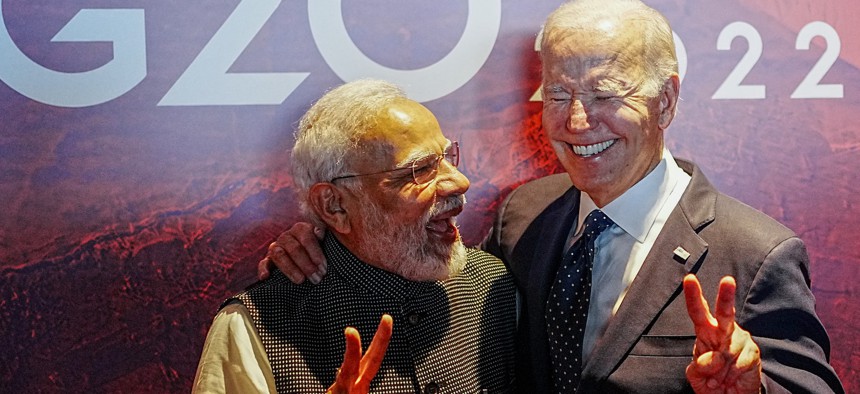
Narendra Modi, prime minister of India, and U.S. President Joe Biden at the G20 summit in Indonesia, November 15, 2022. Kay Nietfeld / picture alliance via Getty Images
As Modi Preps for US Visit, Mideast Leaders Study India’s Nonalignment
Many Middle East governments want good ties to the U.S.—without the disrespect.
Middle Eastern governments’ interest in the so-called “China model” is real, but it is superficial. They admire China’s three-decade record combining an authoritarian system with the use of state capital to achieve profound economic change while tightly managing social and political change. China’s experience challenges Western insistence that only liberal systems can produce economic growth and stability. Still, while Middle Eastern states like the idea of following the Chinese path, they are often indifferent to the details.
What governments are paying much closer attention to is the “India model.” That model shows that a country can successfully combine diplomatic nonalignment with intimate ties to all of the world’s biggest economies. India has arguably been pursuing a version of the policy since winning independence more than 75 years ago, but has refined it in recent years. Prime Minister Narendra Modi’s state visit to Washington next week is another sign that the “India model” is working, and Middle Eastern rulers will be watching closely to see exactly how it is done.
Most Middle Eastern states are united by a sense that while they need a close relationship with the United States, the United States disrespects them. The U.S. government criticizes their heavy hand in domestic politics and second guesses their security strategies. It presses them on issues large and small: to open their financial systems to U.S. government scrutiny, to modify their school textbooks, and to normalize ties with Israel. Feeling as if they are too often treated as vassal states, they are hungry to achieve their own sense of agency.
India has done exactly that, calmly articulating when its interests align with the United States and when they do not. India has boosted its defense cooperation with the United States, increasing bilateral consultations and replacing Soviet-era equipment with modern U.S. technology. Yet India has bristled at the concept of acting in concert with the United States and has said it would only do so under UN auspices.
India’s savvy minister of external affairs, S. Jaishankar, wrote in a recent book that “actual policy in a large country is parallel pursuit of multiple priorities, some of which could be contradictory…Choices have to be made, not just debated. And they cannot be without costs.”
In practice, India has managed simultaneously to draw closer to the United States and its allies while remaining pointedly unaligned. U.S.-led groupings such as the “Quad” (which also include Japan and Australia) and “I2U2” (which include the UAE and Israel) seek to build patterns of cooperation that entwine India with some of America’s closest partners. Yet, on issues such as condemning Russia after its invasion of Ukraine, India is nowhere to be found. Similarly, India is building its defenses against China while studiously avoiding activity that might antagonize China.
Arguably, the inflection point in U.S.-India relations was India’s testing of five nuclear devices in 1998. While the immediate aftermath was U.S. sanctions, the longer-term result was a Bush administration effort to embrace India that Bush’s successors have continued. Proof of success is the way the United States continues to praise India as the world’s largest democracy despite starkly illiberal approaches to India’s religious minorities. U.S. diplomats quietly complain that whatever it does, India seems to get a bye.
In a recent article in Foreign Affairs, Ashley Tellis argues that the U.S. partnership with India is badly lopsided. He writes that India “does not harbor any innate allegiance toward preserving the liberal international order and retains an enduring aversion toward participating in mutual defense. It seeks to acquire advanced technologies from the United States to bolster its own economic and military capabilities and thus facilitate its rise as a great power capable of balancing China independently, but it does not presume that American assistance imposes any further obligations on itself.”
Yet successive U.S. administrations have concluded that they need India, and they will make the relationship work.
That is precisely the conclusion that officials in Riyadh and Abu Dhabi and Cairo—and others—would like Washington to reach about them. They would like to have the U.S. president welcome their rulers without lectures or preconditions. They would like U.S. acceptance of their determination to sit out Great Power competition as they watch a unipolar world yielding to a more multipolar one. They would like to develop further their considerable economic ties with China, hedge against U.S. strategic abandonment by maintaining ties with Russia, and bargain with the United States from a position of strength.
That the uptick in U.S.-India relations came as a result of crisis over India’s nuclear program is a cautionary tale for where these ties may go. Some may be assessing that the route to a better U.S. relationship is not a straight line. Instead, a sharp downturn in relations or even a crisis with Washington could provoke a U.S. reassessment of their importance to global security.
One might argue that India is a poor model for these states. It requires no external security guarantors, and its large population, economy and location make it a potential strategic counterweight to China. It has a growing expatriate population in the United States that is increasingly politically engaged and attractive to both political parties.
Regardless, India is a pioneer probing how a more multipolar world works. Through its embrace of the BRICS framework, and its increasingly deft diplomacy throughout the Middle East and the rest of the world, it is both providing newfound legitimacy to the idea of nonalignment and demonstrating exactly how such a policy can be executed. The Modi visit is important for India, but it will be closely watched in the Middle East and around the world.
NEXT STORY: We’re Still Arguing Over Women in the Military?
